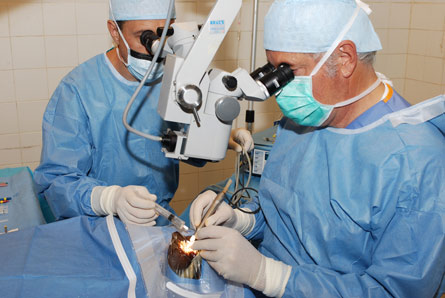Although it was begun in 2003 by the non-government organisation Fatebenefratelli Association for Distant Sick People (AFMAL), the "Bringing back Light" mission has seen the essential participation of the Italian air force since 2004, providing not only transport and logistics support with its Lockheed Martin C-130Js from the Pisa-based's 46th Airlift brigade, but also doctors, paramedics and equipment from the service's health department, in addition to logistics detachment support.
Together with voluntary specialists from different hospitals in Rome and abroad, the military and AFMAL civilian personnel treat eye diseases such as cataracts that in various forms affect a large percentage of the population in sub-Saharan Africa. The team has accomplished 10 missions with more than 19,000 visits and 3,600 surgical cataract operations since the Italian air force and Alenia Aeronautica came on board earlier this decade.
 |
|---|
© Luca PeruzziThe C-27J flying low over the Niger river |
"Bringing back Light aims to free children who often are required to act as guides for blind people from a young age, depriving them of their childhood, education, playtime and prospects," says Fra Gerardo D'Auria, AFMAL's Italy vice-president. "At the same time, we enable the adults to live autonomously, giving them back their sight with these operations."
The Italian air force has so far supported 11 AFMAL operations throughout Africa, including in Benin, Chad, Ghana, Mali, Tanzania and Togo. However, due to concurrent deployments, since 2007 its C-130Js were augmented and sometimes replaced by an Alenia-operated C-27J transport, together with crews and ground personnel belonging to the company's flying operations department.
SPARTAN TASKS
For last year's mission, only Alenia Aeronautica's C-27J Spartan was available, and this "transported everything, from material to personnel and patients. More than 20 missions were flown in a 15-day period between the end of November and the beginning of December," says Marco Venanzetti, head of Alenia Aeronautica flying operations and test pilot.
"We logged over 70 flying hours, transporting 10,000kg [22,000lb] of cargo and 40 passengers, including medical personnel from the Italian air force and two hospitals in Rome and Spain. All flights were carried out successfully with no technical problems, operating throughout a wide range of operational conditions, from torrential rain and extraordinarily strong crosswinds during landings at Pratica di Mare airbase, to extreme heat and a dust storm in Gao [Mali], to the intense cold and strong altitude wind [up to 60kt/111km/h] during the flights", says Venanzetti.
The third C-27J prototype, with a crew including the two test pilots and an eight-strong Alenia support team, flew the 3,165km (1,710nm) and 7h single-leg sortie between Pratica di Mare and Gao on 1 December. The aircraft left Italy at close to its maximum take-off weight, carrying 19 passengers (including medical personnel and journalists) and resupply material.
Some 45 passengers, including Capt Emanuele Di Francesco of the 46th Airlift Bridage/98th Sqn - the Italian air force's C-27J operating unit - were embarked for a return flight on 4 December.
The Alenia aircraft had already been deployed, together with an Italian air force C-130J, to carry medical equipment, personnel and logistics material at the start of the operation.
While in previous missions, C-27Js and C-130Js flew several flights from up to three airports, including Mali's capital Bamako, plus Gao and Mopti, the 2009 mission was concentrated on Gao district. The Italian foreign ministry will build and manage an ophthalmology centre for treating eye diseases with local medical personnel from 2010.
Apart from Bamako, other airports have only basic - if any - navigation and landing aids, such as runway edge lighting and VOR-only equipment, as at Gao, which restrict procedures to good visibility and daylight.
During its visit, the C-27J was the only aircraft parked at Gao airport, expect for an Aerospatiale Lama used for agriculture spraying. "Before landing we usually conduct a flyover to control the runway status, as intrusions by animals, vehicles and human beings is a concrete possibility," says Venanzetti.
The C-27J's self-contained navigation and communications suite, structural robustness, transport and short take-off and landing performances, in addition to already demonstrated suitability for unprepared strips, are considered essential characteristics for this kind of mission. Movements on the scarce road network present security issues, while minor airports have shorter and unasphalted runways.
"The C-27J's wide transport compartment is an important feature for humanitarian missions, as cargo volume requirements are more important than weight in most conditions," says Venanzetti. The C-27J can carry up to 36 litters, plus six medical attendants, and has been used by the Italian air force for infectious patient airlift.
During the mission, the medical team including specialists and paramedics from hospitals in Rome and Siviglia, Spain, and from the Italian air force and army, were engaged in cataract or eye disease operations at Gao hospital.
CATARACT OPERATIONS
"As this infrastructure is not yet equipped with an ophthalmology centre, we have been carrying all the equipment for three surgical rooms from Italy on board the aircraft. Our medical team was conducting an average of 60 cataract operations a day, with patients ranging from babies to old persons," says D'Auria. "As the local medical personnel are not trained and equipped yet, the more operations we can conduct in such a short time, the more people can return to normal life."
 |
|---|
© Luca PeruzziThe medical team perform an average of 60 cataract operations a day. Patients range from babies to older people |
Other priorities included training local medical personnel and endoscopic digestive surgeries, which were two firsts for the long-running mission. "The Bringing back Light project is a clear example of how our country is able to bring together its resources to 'give back life' to the third world population in a way that is both concrete and hands-on," says chief general inspector Ottavio Sarlo, head of the Italian air force's health department.
Source: Flight International























